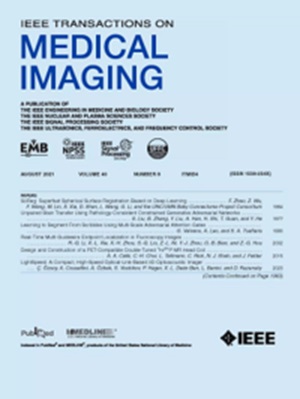用于肺结节分析的具有边际排序损失的多任务深度模型
IF 8.9
1区 医学
Q1 COMPUTER SCIENCE, INTERDISCIPLINARY APPLICATIONS
引用次数: 79
摘要
癌症是全球癌症死亡的主要原因,肺结节的早期诊断对治疗和挽救生命具有重要意义。自动肺结节分析需要准确的肺结节良恶性分类和属性评分回归。然而,这是相当具有挑战性的,因为肺结节异质性建模相当困难,并且对模糊病例的识别能力有限。为了解决这些挑战,我们提出了一种具有边际排名损失的多任务深度模型(称为MTMR-Net),用于自动肺结节分析。与分别考虑这两项任务的现有方法相比,在我们的多任务深度模型中,以因果关系的方式明确探讨了肺结节分类和属性得分回归之间的相关性,这有助于提高这两项工作的性能。不同任务的结果可以同时产生,以帮助放射科医生进行诊断解释。此外,精心设计了一个具有边际排名损失的暹罗网络,以增强对模糊结节病例的识别能力。为了进一步探索两个任务之间的内部关系并验证所提出的模型的有效性,我们使用递归特征消除方法对与恶性肿瘤最相关的特征进行迭代排序。我们在公共基准LIDC-IDRI数据集上验证了我们的方法MTMR-Net的有效性。大量实验表明,在我们的模型中明确探索的具有内部关系的诊断结果在临床使用中符合一些类似的模式,也表明我们的方法可以实现有竞争力的分类性能和比现有技术更准确的属性评分。代码可在以下网址公开获取:https://github.com/CaptainWilliam/MTMR-NET.本文章由计算机程序翻译,如有差异,请以英文原文为准。
Multi-Task Deep Model With Margin Ranking Loss for Lung Nodule Analysis
Lung cancer is the leading cause of cancer deaths worldwide and early diagnosis of lung nodule is of great importance for therapeutic treatment and saving lives. Automated lung nodule analysis requires both accurate lung nodule benign-malignant classification and attribute score regression. However, this is quite challenging due to the considerable difficulty of lung nodule heterogeneity modeling and the limited discrimination capability on ambiguous cases. To solve these challenges, we propose a Multi-Task deep model with Margin Ranking loss (referred as MTMR-Net) for automated lung nodule analysis. Compared to existing methods which consider these two tasks separately, the relatedness between lung nodule classification and attribute score regression is explicitly explored in a cause-and-effect manner within our multi-task deep model, which can contribute to the performance gains of both tasks. The results of different tasks can be yielded simultaneously for assisting the radiologists in diagnosis interpretation. Furthermore, a Siamese network with a margin ranking loss is elaborately designed to enhance the discrimination capability on ambiguous nodule cases. To further explore the internal relationship between two tasks and validate the effectiveness of the proposed model, we use the recursive feature elimination method to iteratively rank the most malignancy-related features. We validate the efficacy of our method MTMR-Net on the public benchmark LIDC-IDRI dataset. Extensive experiments show that the diagnosis results with internal relationship explicitly explored in our model has met some similar patterns in clinical usage and also demonstrate that our approach can achieve competitive classification performance and more accurate scoring on attributes over the state-of-the-arts. Codes are publicly available at: https://github.com/CaptainWilliam/MTMR-NET.
求助全文
通过发布文献求助,成功后即可免费获取论文全文。
去求助
来源期刊

IEEE Transactions on Medical Imaging
医学-成像科学与照相技术
CiteScore
21.80
自引率
5.70%
发文量
637
审稿时长
5.6 months
期刊介绍:
The IEEE Transactions on Medical Imaging (T-MI) is a journal that welcomes the submission of manuscripts focusing on various aspects of medical imaging. The journal encourages the exploration of body structure, morphology, and function through different imaging techniques, including ultrasound, X-rays, magnetic resonance, radionuclides, microwaves, and optical methods. It also promotes contributions related to cell and molecular imaging, as well as all forms of microscopy.
T-MI publishes original research papers that cover a wide range of topics, including but not limited to novel acquisition techniques, medical image processing and analysis, visualization and performance, pattern recognition, machine learning, and other related methods. The journal particularly encourages highly technical studies that offer new perspectives. By emphasizing the unification of medicine, biology, and imaging, T-MI seeks to bridge the gap between instrumentation, hardware, software, mathematics, physics, biology, and medicine by introducing new analysis methods.
While the journal welcomes strong application papers that describe novel methods, it directs papers that focus solely on important applications using medically adopted or well-established methods without significant innovation in methodology to other journals. T-MI is indexed in Pubmed® and Medline®, which are products of the United States National Library of Medicine.
 求助内容:
求助内容: 应助结果提醒方式:
应助结果提醒方式:


